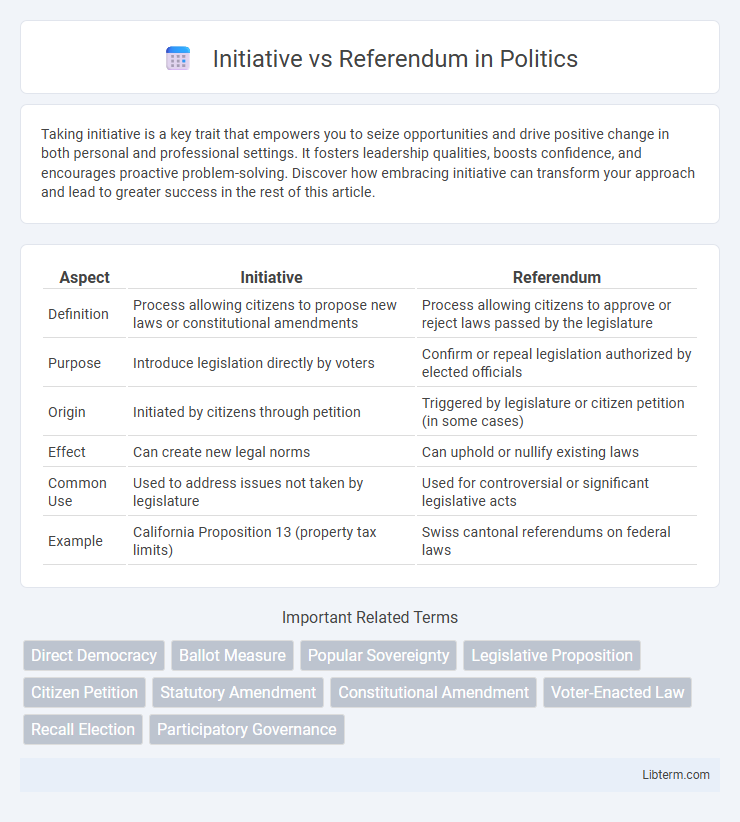Taking initiative is a key trait that empowers you to seize opportunities and drive positive change in both personal and professional settings. It fosters leadership qualities, boosts confidence, and encourages proactive problem-solving. Discover how embracing initiative can transform your approach and lead to greater success in the rest of this article.
Table of Comparison
| Aspect | Initiative | Referendum |
|---|---|---|
| Definition | Process allowing citizens to propose new laws or constitutional amendments | Process allowing citizens to approve or reject laws passed by the legislature |
| Purpose | Introduce legislation directly by voters | Confirm or repeal legislation authorized by elected officials |
| Origin | Initiated by citizens through petition | Triggered by legislature or citizen petition (in some cases) |
| Effect | Can create new legal norms | Can uphold or nullify existing laws |
| Common Use | Used to address issues not taken by legislature | Used for controversial or significant legislative acts |
| Example | California Proposition 13 (property tax limits) | Swiss cantonal referendums on federal laws |
Introduction to Initiative and Referendum
Initiative and referendum are democratic processes that empower citizens to directly participate in lawmaking by proposing or approving legislation. An initiative allows voters to bypass the legislature by placing proposed statutes or constitutional amendments on the ballot through collected signatures. A referendum enables voters to approve or reject laws already passed by the legislature, serving as a form of direct democratic check on government decisions.
Definitions: What is an Initiative?
An initiative is a process that allows citizens to propose new laws or constitutional amendments by collecting a required number of signatures to place the measure on the ballot for a public vote. This form of direct democracy bypasses the legislature, empowering voters to enact or reject legislation independently. Initiatives vary by jurisdiction but typically require rigorous validation of signatures and compliance with legal standards before qualification.
Definitions: What is a Referendum?
A referendum is a direct voting process in which citizens are asked to approve or reject a specific legislative act, policy, or constitutional amendment. It serves as a form of direct democracy, allowing the electorate to make decisions on important issues rather than relying solely on elected representatives. Referendums are commonly used to validate laws or propose significant changes at local, regional, or national levels.
Key Differences Between Initiative and Referendum
Initiative allows citizens to propose new laws or amendments by gathering signatures, while referendum enables voters to approve or reject laws already passed by the legislature. The initiative process is proactive, originating from the public, whereas referendum is reactive, providing a check on legislative decisions. Key distinctions include the source of the proposal and the stage at which voters intervene in the legislative process.
Historical Origins and Development
The initiative and referendum processes trace their origins to the Progressive Era reforms in the late 19th and early 20th centuries, aimed at increasing direct democracy in the United States. Pioneered in states like Oregon during the early 1900s, these mechanisms empowered citizens to propose and approve laws independently of legislative bodies. Over time, the initiative and referendum have evolved across numerous states, reflecting a shift towards greater public participation in governance and policy-making.
How the Initiative Process Works
The initiative process allows citizens to propose new laws or constitutional amendments by collecting a required number of signatures from registered voters within a specified time frame. Once the petition meets the legal threshold, the proposed measure is placed on the ballot for a public vote during an election. This direct form of democracy empowers voters to bypass the legislature and directly shape policy through popular approval.
How the Referendum Process Works
The referendum process allows voters to approve or reject laws passed by the legislature through a direct vote on specific ballot measures. Citizens or advocacy groups typically gather a required number of signatures to place a referendum on the ballot, triggering a public vote during an election. This process ensures direct democratic participation by enabling the electorate to confirm or repeal legislative decisions.
Advantages and Disadvantages
Initiative allows citizens to propose and vote on laws directly, increasing democratic participation but risking poorly crafted legislation due to lack of expert input. Referendums enable the public to approve or reject laws passed by legislatures, ensuring a check on government power yet potentially causing delays in policy implementation. Both tools empower voters but may lead to voter fatigue and oversimplification of complex issues.
Real-World Examples and Case Studies
California's Proposition 13, passed via initiative in 1978, significantly reduced property taxes and set a precedent for fiscal policy referendums nationwide. Switzerland exemplifies direct democracy with frequent referendums, such as the 2020 vote on COVID-19 measures, reflecting public consensus on health policy. Oregon's Measure 110 decriminalized drug possession in 2020 through an initiative, showcasing the evolving use of ballot measures to influence criminal justice reform.
Impact on Democracy and Governance
Initiative and referendum processes enhance democracy by enabling direct citizen participation in lawmaking, reducing reliance on legislators, and increasing governmental accountability. These mechanisms empower voters to propose or reject laws, promoting transparency and responsiveness in governance. However, they may also lead to challenges such as oversimplification of complex policies and potential influence by special interest groups.
Initiative Infographic

 libterm.com
libterm.com